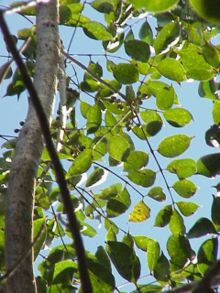Bursera: Difference between revisions
Content deleted Content added
WriterHound (talk | contribs) →Species: +link to pic |
No edit summary |
||
| Line 73: | Line 73: | ||
*''[[Bursera heliae]]''<ref name="diverse"/> |
*''[[Bursera heliae]]''<ref name="diverse"/> |
||
*''[[Bursera kerberii]]''<ref name="diverse"/> |
*''[[Bursera kerberii]]''<ref name="diverse"/> |
||
*''[[Bursera |
*''[[Bursera krusei]]''<ref name="diverse"/> |
||
*''[[Bursera lancifolia]]''<ref name="diverse"/> |
*''[[Bursera lancifolia]]''<ref name="diverse"/> |
||
*''[[Bursera laurihuertae]]''<ref name="diverse"/> |
*''[[Bursera laurihuertae]]''<ref name="diverse"/> |
||
Revision as of 23:07, 6 April 2009
| Bursera | |
|---|---|

| |
| Bursera simaruba | |
| Scientific classification | |
| Kingdom: | |
| (unranked): | |
| (unranked): | |
| (unranked): | |
| Order: | |
| Family: | |
| Genus: | Bursera |
| Species | |
|
About 100. See text. | |
Bursera is a genus of about 100 species[1] of flowering plants in the family Burseraceae, native to tropical and warm temperate regions of the Americas, from the southern United States south to northern Argentina. A number of species from tropical Asia sometimes included in the genus are now treated in the separate genus Protium.
The species are shrubs and small to medium-sized trees up to 25 m tall.
Species
- Bursera acuminata[2]
- Bursera aloexylon (Schiede ex Schltdl.) Engl.[2]
- Bursera arida[2]
- Bursera aptera[2]
- Bursera arborea[2]
- Bursera atenuata[2]
- Bursera aspleniifolia[2]
- Bursera bicolor[2]
- Bursera biflora[2]
- Bursera bipinnata[2]
- Bursera bolivarii[2]
- Bursera bonetti[2]
- Bursera cerasifolia[2]
- Bursera chemapodicta[2]
- Bursera cinera[2]
- Bursera citronella[2]
- Bursera compacta[2]
- Bursera copallifera[2]
- Bursera coyucensis[2]
- Bursera crenata[2]
- Bursera cuneata[2]
- Bursera delpechiana Poiss. ex Engl.
- Bursera denticulata[2]
- Bursera discolor[2]
- Bursera diversifolia[2]
- Bursera epinnata[2]
- Bursera excelsa (Kunth) Engl. [2]
- Bursera fagaroides (Kunth) Engl.[2] (Bonsai picture: [1])
- Bursera fagaroides elong.[2]
- Bursera filicifolia[2]
- Bursera fragantissima[2]
- Bursera fragilis[2]
- Bursera galeottiana Engl.[2]
- Bursera glabrifolia (Kunth) Engl.[2]
- Bursera grandifolia[2]
- Bursera graveolens (Kunth) Triana & Planch.
- Bursera heteresthes[2]
- Bursera hindsiana[2]
- Bursera hintonii[2]
- Bursera infiernidialis[2]
- Bursera instabilis[2]
- Bursera isthmica[2]
- Bursera heliae[2]
- Bursera kerberii[2]
- Bursera krusei[2]
- Bursera lancifolia[2]
- Bursera laurihuertae[2]
- Bursera laxiflora[2]
- Bursera leptophloeos Engl.
- Bursera longpipes[2]
- Bursera macvaughiana[2]
- Bursera malacophylla B.L.Rob.
- Bursera medranoana[2]
- Bursera microphylla A.Gray[2]
- Bursera mirandae[2]
- Bursera morelensis[2]
- Bursera multifolia[2]
- Bursera multijuga[2]
- Bursera nespola[2]
- Bursera odorata[2]
- Bursera occulta[2]
- Bursera palaciosii[2]
- Bursera palmeri[2]
- Bursera penicillata (DC.) Engl.
- Bursera ribana[2]
- Bursera rzedowski[2]
- Bursera ruticola[2]
- Bursera sarkopoda[2]
- Bursera sarukhanii[2]
- Bursera schlechtendalii Engl.[2]
- Bursera simaruba (L.) Sarg.[2]
- Bursera staphyleoides[2]
- Bursera stenophylla[2]
- Bursera submoniliformis[2]
- Bursera suntui[2]
- Bursera techomaca[2]
- Bursera tomentosa[2]
- Bursera tonkinensis Guillaum.
- Bursera trifoliolata[2]
- Bursera trimera[2]
- Bursera vasquezyanesii[2]
- Bursera vejar-vazquezii[2]
- Bursera velutina[2]
- Bursera xochipalensis[2]
The genus is named after the Danish botanist Joachim Burser (1583-1639).
Gallery
-
Bursera citronella
References
- ^ Becerra, Judith X. (2008). "Sources and Sinks of Diversification and Conservation Priorities for the Mexican Tropical Dry Forest". PLoS ONE. 3 (10): e3436. doi:10.1371/journal.pone.0003436.
{{cite journal}}: Unknown parameter|coauthors=ignored (|author=suggested) (help); Unknown parameter|quotes=ignored (help)CS1 maint: unflagged free DOI (link) - ^ a b c d e f g h i j k l m n o p q r s t u v w x y z aa ab ac ad ae af ag ah ai aj ak al am an ao ap aq ar as at au av aw ax ay az ba bb bc bd be bf bg bh bi bj bk bl bm bn bo bp bq br bs bt bu bv bw bx by bz "Sources and Sinks of Diversification and Conservation Priorities for the Mexican Tropical Dry Forest". www.pubmedcentral.nih.gov. Retrieved 2009-01-13.

